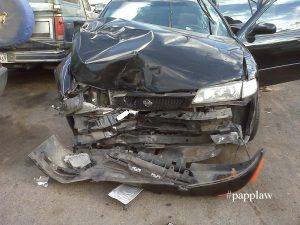Trucking Litigation

Trucking Accident
In addition to the usual contractual matters that come up between carriers and customers such as payments, damaged freight, theft and the like, unfortunately, personal injuries can come into play on occasion as well.
California Civil Jury Instructions (CACI)
901. Status of Common Carrier Disputed
To prove that [name of defendant] was a common carrier, [name of plaintiff] must prove that it was in the business of transporting [the property of] the general public.
In deciding this issue, you may consider whether any of the following factors apply. These factors suggest that a carrier is a common carrier:
(a) The carrier maintains a regular place of business for the purpose of transporting passengers [or property].
(b) The carrier advertises its services to the general public.
(c) The carrier charges standard fees for its services.
(d) [Insert other applicable factor(s).]
A carrier can be a common carrier even if it does not have a regular schedule of departures, a fixed route, or a transportation license.
If you find that [name of defendant] was not a common carrier, then [name of defendant] did not have the duty of a common carrier, only a duty of ordinary care.
///
It goes without saying that trucks are massive. And, it also goes without saying that most trucking companies and drivers do their utmost to keep the public safe. There are numerous state and federal organizations, laws and procedures to ensure that the trucking industry safely maintains their trucks and buses and that their drivers are well rested and not operating under the influence of drugs or alcohol. But, we also recognize that things can go wrong, very wrong – just do the math: Force = mass x acceleration.
The Federal Motor Carrier Safety Administration (FMCSA) is one of many such organizations. The FMCSA’s “Primary mission is to prevent commercial motor vehicle-related fatalities and injuries. Activities of the Administration contribute to ensuring safety in motor carrier operations through strong enforcement of safety regulations; targeting high-risk carriers and commercial motor vehicle drivers; improving safety information systems and commercial motor vehicle technologies; strengthening commercial motor vehicle equipment and operating standards; and increasing safety awareness. To accomplish these activities, the Administration works with Federal, State, and local enforcement agencies, the motor carrier industry, labor and safety interest groups, and others.” (https://www.fmcsa.dot.gov)
To this end, “the FMCSA Safety and Fitness Electronic Records (SAFER) System offers company safety data and related services to industry and the public over the Internet. Users can search FMCSA databases, register for a USDOT number, pay fines online, order company safety profiles, challenge FMCSA data using the DataQs system, access the Hazardous Material Route registry, obtain National Crash and Out of Service rates for Hazmat Permit Registration, get printable registration forms and find information about other FMCSA Information Systems.” http://safer.fmcsa.dot.gov/
Also, be sure to visit the live traffic cameras provided by the California Department of Transportation, live traffic cameras. http://www.dot.ca.gov/video/
///
California Civil Jury Instructions (CACI)
401. Basic Standard of Care
Negligence is the failure to use reasonable care to prevent harm to oneself or to others.
A person can be negligent by acting or by failing to act. A person is negligent if he or she does something that a reasonably careful person would not do in the same situation or fails to do something that a reasonably careful person would do in the same situation.
You must decide how a reasonably careful person would have acted in [name of plaintiff/defendant]’s situation.
Click link for a complete listing of the Judicial Council of California Civil Jury Instructions (CACI).
Eric Papp, Esq.
